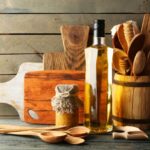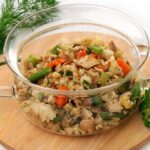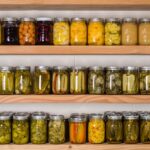Stoneware is a type of clay that has been fired at very high temperatures to create strong, safe, and chip-resistant materials. The approximate temperature for firing stoneware is 2,185°F and this process takes about 12 hours. Stoneware is known for its strength and durability. It can be safely used in the oven at any temperature and is often used to make various cooking and baking dishes.
Stoneware can be decorated with a colored or clear glaze or left unglazed.
Is Stoneware Safe for Cooking Food?
Stoneware is a hard, chemically inert material. This chemical stability makes stoneware vessels safe for cooking food. However, because stoneware is made from natural clay, some inexpensive brands may contain traces of lead, cadmium, and other substances that can leach toxins into food.
Stoneware manufactured in the USA and Canada is tested and must meet the applicable food contact regulations. Stoneware products should be tested in an independent laboratory to ensure they meet FDA and California Proposition 65 compliance standards for food-safe surfaces.

You must carefully check whether the earthenware item you are going to purchase is made from lead-free clay and therefore can be used for cooking food. Only purchase stoneware from a reputable manufacturer and check the specifications to ensure it is lead-free.
Be especially careful when purchasing imported, handmade, and heavily decorated items. The earthenware piece should not be used for food preparation and storage if the label states that the product is for decorative purposes only.
If you are concerned about the safety of your stoneware vessels, you can buy special test kits that can detect the presence of lead in the surface layer.

Advantages of Using Stoneware for Baking
Stoneware works perfectly for baking, slow cooking, and serving food. Earthenware cookware has been used for centuries. Recently, stoneware is making a comeback and is one of the most popular materials for making bakeware. Due to its heat retention properties and uniform baking, it is preferred over other materials such as tinned steel, cast iron, aluminum, and tempered glass. Food cooked in stoneware has a cleaner flavor than food cooked in metal cookware.
Unglazed stoneware is often used for baking dishes that need to be light and crispy. Bread baked in a stoneware loaf pan is crispier than bread baked on a metal tray.
The rustic aesthetic makes stoneware ideal for family gatherings and special occasions.
1. Durability
Stone bakeware can withstand the highest possible oven temperatures, making it perfect for baking food in the oven.
Stoneware bakery and dinner sets are chip-resistant and retain their strength under normal use. If well cared for, they will remain functional for many decades and can be passed on from one generation to the next.
2. Even Baking
Stoneware baking dishes can retain heat, keeping your food warm on the table. This property makes them particularly suitable for baked goods that need to be evenly and beautifully browned.
Stone baking pans allow for even heat distribution and ensure a consistent baking temperature to ensure a crispy texture without burnt spots. Baked goods have a nice, crispy crust and can be easily removed from the pan.
3. Natural Stick-Resistance
Stoneware has a naturally non-stick surface, so you don’t need oil to release the food. Follow the manufacturer’s instructions for use and maintenance. In most cases, you don’t need to season the pan. However, you can use oil and bake the pan at a high temperature to improve the non-stick surface with repeated use. Unglazed stoneware forms dark layers that do not affect the non-stick properties. In fact, “the worse it looks, the better it cooks.”
4. Versatility
Stoneware dishes can be used in both a conventional oven and a microwave oven. These multi-purpose dishes allow you to bake everything from crispy pizzas to crusty bread to evenly browned cookies. Stoneware pans and pots can be placed in a refrigerator or freezer to store food. However, be sure to avoid sudden temperature changes.
5. Ease of Cleaning
Stoneware dishes have a smooth surface that is easy to maintain and clean. They don’t absorb the flavors or retain the odors of the food you have cooked in them. Some stoneware pieces can be safely put in a dishwasher, but they are also very easy to wash by hand. Wash your stoneware in hot water, after removing bits of food with a rubber scraper.
If you have baked something that comes off easily, give a quick wipe with a dry cloth to remove any leftover food.
6. Visual Appeal
The rustic design makes stoneware attractive for serving food. The old-world feel adds style to your dining table. Aesthetic appeal coupled with safety and supreme functionality make stoneware a popular choice for professional chefs and home cooking enthusiasts.
Related stoneware product: The Pampered Chef Stoneware Loaf Pan (Amazon)
Disadvantages of Stoneware
- The sudden temperature changes can cause stoneware to crack. To avoid thermal shock, allow the pan to cool before placing it in the freezer, refrigerator, or under cold water to clean. After removing the pan from the freezer, wait until it reaches room temperature before placing it in the oven or microwave.
- Stoneware pieces are too heavy to pick up and move. Their weight can damage other dishes. Therefore, keep it on the bottom shelf of your cupboard.
- Stoneware dishes can scratch the countertop, so you’ll need a sort of protective mat to place underneath.





How do you know how long to bake an item in a stoneware baking dish?
It may take some time and practice, but for most items, you don’t have to make adjustments in baking time. Stoneware takes longer to heat up, but it also retains heat for longer than some thin bakeware pieces made from aluminum, silicone or carbon steel. The food that requires short baking needs more attention and you will need to slightly increase baking time.